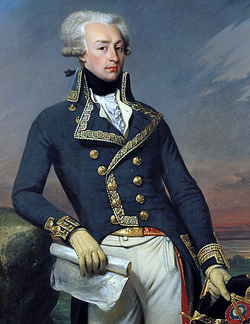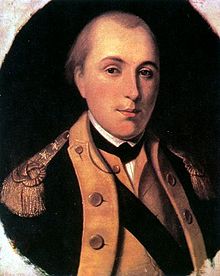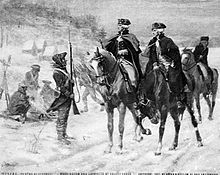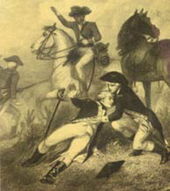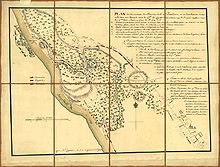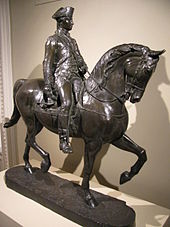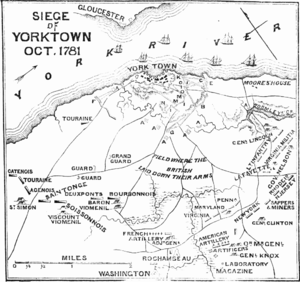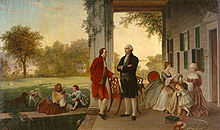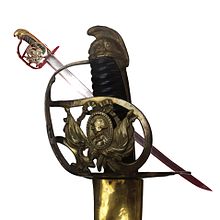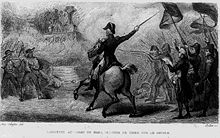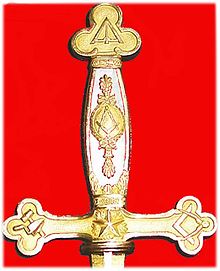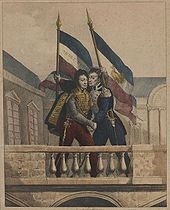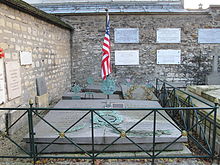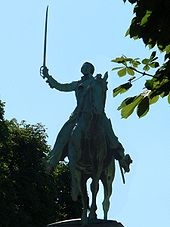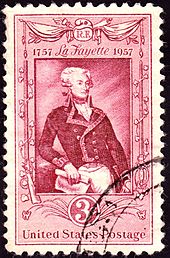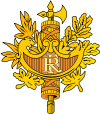- Gilbert du Motier, marquis de Lafayette
-
Lafayette 
Born 6 September 1757
Chavaniac, FranceDied 20 May 1834 (aged 76)
Paris, FranceAllegiance France
United States of AmericaRank  Major General (US)
Major General (US)
Maréchal de camp (France)Battles/wars Relations Wife: Marie Adrienne Françoise de Noailles (1759 –1807)
Uncle: Jacques-Roch
Son: Georges Washington (1779–1849)
Daughters: Anastasie (1777–1863)
Virginie (1782–1849)Other work Politician
Estates General (Auvergne)
Member of the National AssemblyMarie-Joseph Paul Yves Roch Gilbert du Motier, Marquis de La Fayette (French pronunciation: [maʁki də la fajɛt]; 6 September 1757 – 20 May 1834), often known as simply Lafayette, was a French aristocrat and military officer born in Chavaniac, in the province of Auvergne in south central France. Lafayette was a general in the American Revolutionary War and a leader of the Garde nationale during the French Revolution.
In the American Revolution, Lafayette served as a major-general in the Continental Army under George Washington. Wounded during the Battle of Brandywine, he still managed to organize a successful retreat. He served with distinction in the Battle of Rhode Island. In the middle of the war he returned to France to negotiate an increase in French support. On his return, he blocked troops led by Cornwallis at Yorktown while the armies of Washington and those sent by King Louis XVI under the command of General de Rochambeau, Adniralde Grasse, and Admiral de Latouche Tréville prepared for battle against the British.
Back in France in 1788, Lafayette was called to the Assembly of Notables to respond to the fiscal crisis. Lafayette proposed a meeting of the French Estates-General, where representatives from the three traditional orders of French society—the clergy, the nobility and the commoners—met. He served as vice president of the resulting body and presented a draft of the Declaration of the Rights of Man and of the Citizen. Lafayette was appointed commander-in-chief of the Garde nationale in response to violence. During the French Revolution, Lafayette attempted to maintain order—to the point of ordering the Garde nationale to fire on demonstrators at the Champ de Mars in July 1791—for which he ultimately was persecuted by the Jacobins. In August 1792, as the radical factions in the Revolution grew in power, Lafayette tried to flee to the United States through the Dutch Republic. He was captured by Austrians and spent more than five years in prison.
Lafayette returned to France after Napoleon Bonaparte secured his release from prison in 1797. He refused to participate in Napoleon's government, but was elected to the Chamber of Deputies under the Charter of 1815, during the Hundred Days. With the Bourbon Restoration, Lafayette became a liberal member of the Chamber of Deputies in 1815, a position he held until his death. In 1824, President James Monroe invited Lafayette to the United States as the "nation's guest"; during the trip, he visited all twenty-four states. For his contributions to the American Revolution, many cities and monuments throughout the United States bear his name. During France's July Revolution of 1830, Lafayette declined an offer to become the French dictator; instead he supported Louis-Philippe's bid as a constitutional monarch. Lafayette died on 20 May 1834, and is buried in Picpus Cemetery in Paris, under soil from Washington's grave at Mount Vernon. He became a United States citizen during his lifetime, and received honorary United States citizenship in 2002.
Contents
Ancestry
Further information: La Fayette familyLafayette was born on 6 September 1757 to Michel Louis Christophe Roch Gilbert Paulette du Motier, Marquis de La Fayette, colonel aux Grenadiers de France, and Marie Louise Jolie de La Rivière, at the château de Chavaniac, in Chavaniac, near Le Puy-en-Velay, in the modern department of Haute-Loire.[1] His full name is rarely used; instead he is often referred to as the marquis de La Fayette or Lafayette. Biographer Louis R. Gottschalk says that Lafayette spelled his name both Lafayette and LaFayette.[2]
Lafayette's lineage appears to be one of the oldest in Auvergne. Members of the family were noted for their contempt for danger.[3] Lafayette's ancestor, Marshal of France Gilbert de La Fayette III, was a companion-at-arms who led Joan of Arc's army in Orléans. His great-grandfather was the Comte de La Rivière, a former lieutenant general in the Royal Armées. According to legend, another ancestor acquired the Crown of Thorns during the 6th Crusade.[4] Lafayette's uncle Jacques-Roch died fighting the Austrians and left the marquis title to Lafayette's father.[5]
Lafayette's father, struck by a cannonball at the Battle of Minden in Westphalia, died on 1 August 1759.[6] Lafayette became Lord of Chavaniac, but the estate went to his mother. Lafayette's mother and his maternal grandfather, Marquis de La Rivière, died, on 3 April and 24 April 1770 respectively, leaving Lafayette an income of 25,000 livres. Upon the death of an uncle, the 12-year-old Lafayette inherited a handsome yearly income of 120,000 livres.[6] Lafayette was raised by his paternal grandmother, Mme de Chavaniac, who had brought the château into the family with her dowry. Also in the household were Mme de Chavaniac's daughters Madeleine du Motier, and Charlotte de Guérin, the Baronne de Chavaniac.[5]
Departure from France
Joining the American War
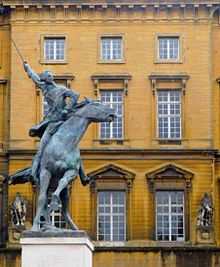 Statue of Lafayette in front of the Governor Palace in Metz, place of the diner of Metz, when he decided of joining the colors.
Statue of Lafayette in front of the Governor Palace in Metz, place of the diner of Metz, when he decided of joining the colors.
In 1775, Lafayette took part in his unit's annual training in Metz, where he met Charles-François de Broglie, marquis de Ruffec, the Army of the East's commander. When he first learned of that quarrel, he wrote, "My heart was enlisted and I thought only of joining the colors."[7]
Lafayette returned to Paris in the fall and participated in sociétés de pensée (thinking groups) that discussed French involvement in the American Revolution. At these meetings, a frequent speaker, Abbé Guillaume Raynal emphasised the "rights of man". He criticised the nobility, the clergy and the practice of slavery. The monarchy banned Raynal from speaking, and he expressed his views secretly in the Masonic Lodges of which Lafayette was a member.[8]
On 7 December 1776, Lafayette arranged through Silas Deane, an American agent in Paris, to enter the American service as a major general.[9] Lafayette visited his uncle Marquis de Noailles, the Ambassador to Britain.[10] During a ball at Lord George Germain's, he met Lord Rawdon,[11] met Sir Henry Clinton at the Opera, and met Lord Shelburne at breakfast.[12] Lafayette refused to toast King George, and left after three weeks.[13] In 1777, the French government granted the American military one million livres in supplies after Minister Charles Gravier pressed for French involvement. De Broglie intrigued with his old subordinate, German Johann de Kalb, (who had previously done a reconnaissance of America), to send French officers to fight alongside the Americans, (and perhaps set up a French generalissimo).[14] De Broglie approached Gravier, suggesting assistance to the American revolutionaries. De Broglie then presented Lafayette, who had been placed on the reserve list, to de Kalb.[15]
Departure for America
Returning to Paris, Lafayette found that the Continental Congress did not have the money for his voyage; hence he acquired the sailing ship La Victoire himself.[13] The king officially forbade him to leave after British spies discovered his plan, and issued an order for Lafayette to join his father-in-law's regiment in Marseille,[16] disobedience of which would be punishable by imprisonment. The British ambassador ordered the seizure of the ship Lafayette was fitting out at Bordeaux, and Lafayette was threatened with arrest.[16][17][18] He travelled to Spain for support in the American cause. On 20 April 1777, he sailed for America, disguised as a woman,[19] leaving his pregnant wife in France.[20] The ship's captain intended to stop in the West Indies to sell cargo; however Lafayette, fearful of arrest, bought the cargo to avoid docking at the islands.[16] He landed on North Island near Georgetown, South Carolina, on 13 June 1777.[13][21]
American Revolution
Main article: Franco-American allianceOn arrival, Lafayette met Major Benjamin Huger, with whom he stayed two weeks before going to Philadelphia. The Continental Congress delayed Lafayette's commission, as they had tired of "French glory seekers". After Lafayette offered to serve without pay, however, Congress commissioned him a major-general on 31 July 1777.[22] Since he was not assigned a unit, he nearly returned home.[23][24]
Benjamin Franklin wrote to George Washington recommending acceptance of Lafayette as his aide-de-camp, hoping it would influence France to commit more aid.[25] Washington accepted, and Lafayette met him at Moland House in Bucks County, Pennsylvania on 10 August 1777.[26] When Washington expressed embarrassment at the state of the camp and the troops, Lafayette responded, "I am here to learn, not to teach."[27] He became a member of Washington's staff, although confusion existed regarding his status. Congress regarded his commission as honorary, while he considered himself a full-fledged commander who would be given control of a division, when Washington deemed him prepared. To address this, Washington told Lafayette that a division would not be possible as he was of foreign birth; however, Washington said that he would be happy to hold him in confidence as "friend and father".[28]
Brandywine, Albany, and the Conway Cabal
Further information: Battle of BrandywineLafayette's first battle was at Brandywine on 11 September 1777.[29] After the British outflanked the Americans, Washington sent Lafayette to join General John Sullivan. Upon his arrival, Lafayette went with the Third Pennsylvania Brigade, under Brigadier Thomas Conway, and attempted to rally the unit to face the attack. In face of the British and Hessian superiority, Lafayette was shot in the leg. During the American retreat, Lafayette rallied the troops, allowing a more orderly retreat before being treated for his wound.[30] After the battle, Washington cited him for "bravery and military ardour" and recommended him for the command of a division in a letter to Congress.[13]
Lafayette returned to the field in November after two months of recuperation in the Moravian settlement at Bethlehem, PA, and received command of Major General Adam Stephen's division.[31] He assisted General Nathanael Greene in reconnaissance of British positions in New Jersey; with 300 soldiers, he defeated a numerically superior Hessian force in Gloucester on 24 November 1777.[32]
He returned to Valley Forge for the winter, where the Horatio Gates led War Board asked him to prepare an invasion of Canada from Albany, New York. Thomas Conway hoped to replace Washington with Gates, who had been successful in the Battle of Saratoga. He concocted a plot known as the Conway Cabal which separated Washington from Lafayette, one of Washington's firmest supporters.[24] Lafayette alerted Washington of his suspicions about the plot before leaving.[33] When Lafayette arrived in Albany, he found too few men to mount a Canadian invasion. He wrote to Washington of the situation, and made plans to return to Valley Forge. Before departing, he recruited the Oneida tribe, who referred to Lafayette as Kayewla (fearsome horseman), to the American side.[13] In Valley Forge, he criticized the War Board's decision to attempt an invasion of Canada in winter. The Continental Congress agreed, and Gates was removed from the Board.[34] Meanwhile, treaties signed by America and France were made public in March 1778, and France formally recognised American independence.[4]
Barren Hill, Monmouth and Rhode Island
Further information: Battle of Barren Hill and Battle of MonmouthThe Americans tried to sense the British forces' reaction to France entering the war. On 18 May 1778, Washington dispatched Lafayette with a 2,200-man force to reconnoitre near Barren Hill, Pennsylvania. The next day, the British heard that Lafayette had made camp nearby and sent 5,000 men to capture him. On 20 May, General Howe led a further 6,000 soldiers and ordered an attack on Lafayette's left flank. The flank scattered, and Lafayette organized a retreat while the British remained indecisive. To feign numerical superiority, he ordered men to appear from the woods on an outcropping known as Barren Hill (now Lafayette Hill) and to fire upon the British periodically.[35] Lafayette's troops simultaneously escaped via a sunken road.[36] Lafayette was then able to cross Matson's Ford with the remainder of his force.[37]
Unable to trap Lafayette, the British resumed their march north from Philadelphia to New York; the Continental Army, including Lafayette, followed and finally attacked at the Monmouth Courthouse[4] in New Jersey. At Monmouth, Washington appointed General Charles Lee to lead the attacking force. On the 28th of June, Lee moved against the British flank; however, soon after fighting began, he began acting strangely. Lafayette sent a message to Washington to urge him to the front; upon his arrival he found Lee's men in retreat. Washington rallied the American force and repelled two British attacks. Due to the day's heat, fighting ended early and the British withdrew in the night.[38]
The French fleet arrived in America on 8 July 1778 under Admiral d'Estaing, with whom General Washington planned to attack Newport, Rhode Island. Lafayette and General Greene were sent with a 3,000 man force to participate in the attack. Lafayette wanted to control a joint Franco-American force in the attack but was rebuffed. On 9 August, the American force attacked the British without consulting d'Estaing. When the Americans asked the admiral to leave his fleet in Narragansett Bay, d'Estaing refused and attacked the British under Lord Howe.[1] The attack dispersed the British fleet, but a storm damaged the French ships.[13]
D'Estaing moved his ships north to Boston for repairs. When the fleet arrived, Bostonians rioted because they considered the French departure from Newport a desertion. John Hancock and Lafayette were dispatched to calm the situation, and then Lafayette returned to Newport to prepare for the retreat made necessary by d'Estaing's departure. For these actions, Lafayette was cited by the Continental Congress for "gallantry, skill and prudence". However he realized that the Boston riot might undermine the Franco-American alliance in France, so he requested and was given permission to return to France.[13]
Return to France
In February 1779, Lafayette returned to Paris. For disobeying the king by going to America, he was placed under house arrest for two weeks. Nevertheless, his return was triumphant.[13] Benjamin Franklin's grandson presented him with a 4,800 livre gold-encrusted sword commissioned by the Continental Congress, and the king asked to see him.[39] Louis XVI, pleased with the soldier after Lafayette proposed schemes for attacking the British, restored his position in the dragoons. Lafayette used his position to lobby for more French aid to America. Working with Franklin, Lafayette secured another 6,000 soldiers to be commanded by General Jean-Baptiste de Rochambeau.[13]
Lafayette received news that Adrienne had borne him a son, Georges Washington Lafayette.[40] After his son's birth, he pushed for additional commitments of support from France for the American Revolutionary War. He ordered new uniforms and arranged for the fleet's departure. Before returning to America, Lafayette and the French force learned that they would be operating under American command, with Washington in control of military operations. In March 1780, Lafayette gave power of attorney to business manager Jacques-Philippe Grattepain-Morizot and Adrienne,[41] and left France, departing for America aboard the Hermione,[42] from Rochefort. He arrived in Boston on 28 April carrying the then secret news that he had secured French reinforcements (5,500 men and 5 frigates) for George Washington.
Virginia and Yorktown
Further information: Southern theater of the American Revolutionary War#YorktownLafayette returned to America in May 1780 and by August was in command of two brigades of light infantry that operated in the Highlands north of New York City. The brigades were commanded by Brigadier Generals Enoch Poor and Edward Hand. These units disbanded late that year and provided LaFayette with additional valuable field command experience.
George Washington drew upon that experience in late February of 1781, placing LaFayette in command of three regiments of light infantry from New England and New Jersey. The regiments were commanded by Colonel Joseph Vose of Massachusetts, LTC Jean-Joseph Sourbader de Gimat of France, and LTC Francis Barber (Colonel) of New Jersey. In all there were about 1,200 light infantry troops. They were sent to Virginia to defend against Benedict Arnold and to replace Baron von Steuben.[43][44] Lafayette evaded Cornwallis' attempts to capture him in Richmond.[44] In June, Cornwallis received orders from London to proceed to the Chesapeake Bay and to oversee construction of a port, in preparation of an attack on Philadelphia.[44] As the British column travelled, Lafayette followed in a bold show of force that encouraged new recruits. In June, Lafayette's men were joined by forces under General (Mad) Anthony Wayne. Soldiers deserted both leaders; Wayne executed six for desertion. Lafayette offered to release his men from service because of the great danger ahead; all of his men remained.[45]
Further information: Battle of Green SpringOn 4 July, the British left Williamsburg and prepared to cross the James River. Cornwallis sent only an advance guard across the river, with intentions to trap, should Lafayette attack. Lafayette ordered Wayne to strike on 6 July with roughly 800 soldiers. Wayne found himself vastly outnumbered against the full British force and, instead of retreating, led a bayonet charge. The charge bought time for the Americans, and Lafayette ordered the retreat. The British did not pursue. The result was a victory for Cornwallis, but the American army was bolstered by the display of courage by the men.[44][46]
Further information: Siege of YorktownBy August, Cornwallis had established the British at Yorktown, and Lafayette took up position on Malvern Hill. This maneuver trapped the British when the French fleet arrived.[4][47] On 14 September 1781, Washington's forces joined Lafayette's, which had succeeded in containing the British until supplies and reinforcements arrived. On 28 September, with the French fleet blockading the British, the combined forces attacked in the Siege of Yorktown. Lafayette's 400 men on the American right took redoubt 9 after Alexander Hamilton's forces had charged redoubt 10, in hand-to-hand combat.[46] After a failed British counter-attack, Cornwallis surrendered on 19 October 1781.[48]
Return to France and visit to America
Lafayette returned to France on 18 December 1781. He was welcomed as a hero, and on 22 January 1782, was received at Versailles. He witnessed the birth of his daughter, whom he named Marie-Antoinette Virginie upon Thomas Jefferson's recommendation.[49][50] He was promoted to maréchal de camp, skipping numerous ranks.[51] Lafayette then helped prepare for a combined French and Spanish expedition against the British West Indies. The Treaty of Paris signed between Great Britain and the U.S. on 20 January 1783 made the expedition unnecessary.[52]
In France, Lafayette worked with Thomas Jefferson to establish trade agreements between the United States and France. These negotiations aimed to reduce U.S. debt to France, and included commitments on tobacco and whale oil.[53] He joined the French abolitionist group Society of the Friends of the Blacks, which advocated the end of the slave trade and equal rights for free blacks. In 1783, in correspondence with Washington, he urged the emancipation of slaves; and to establish them as tenant farmers.[54] Although Washington demurred, Lafayette purchased land in the Cayenne for his plantation La Belle Gabrielle, to "experiment" with education, and emancipation.[54][55][56]
In 1784, Lafayette returned to America, and visited all of the states except Georgia.[57] The trip included a visit to Washington's farm at Mount Vernon on 17 August. In Virginia, Lafayette addressed the House of Delegates where he called for "liberty of all mankind" and urged emancipation.[58] Lafayette advocated to the Pennsylvania Legislature for a federal union, and visited the Mohawk Valley in New York for peace negotiations between the Iroquois, some of whom had met Lafayette in 1778.[59] Lafayette received an honorary degree from Harvard, a portrait of Washington from the city of Boston, and a bust from the state of Virginia. Maryland's legislature honored him by making Lafayette and his male heirs "natural born Citizens" of the state, which made him a natural born citizen of the United States after ratification of the new national Constitution.[60][61][62] Connecticut, Massachusetts, and Virginia also granted him honorary citizenship.[3][63][64]
Upon his return to France, it is said that Lafayette became involved in an affair with the comtesse Aglaé d'Hunolstein,[65] that he broke off on 27 March 1783 by letter, at the insistence of her family.[66] He became briefly linked amorously to Madame de Simiane;[67] however, scholars are divided, whether Adrienne knew of these two extramarital affairs.[68][69] Enemies of Lafayette made much of the court gossip.
Through the next years, Lafayette was active in the Hôtel de La Fayette in the rue de Bourbon, the headquarters of Americans in Paris, where Benjamin Franklin, John Jay and his wife Sarah Livingston, and John Adams and his wife Abigail, met every Monday, and dined in company with family and the liberal nobility, such as Clermont-Tonnerre, and Madame de Staël.[70]
French Revolution
Assembly of Notables and Estates-General
Main articles: Assembly of Notables and Estates-General of 1789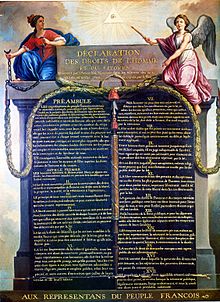 "Declaration of the Rights of Man and of the Citizen", proposed to the Estates-General by Lafayette
"Declaration of the Rights of Man and of the Citizen", proposed to the Estates-General by Lafayette
King Louis XVI convoked the Assembly of Notables on 29 December 1786, in response to France's fiscal crisis. The King appointed Lafayette to the body, in the comte d'Artois' division, which met on 22 February 1787. In an address first read to the assembly, then signed and endorsed by Lafayette, it was argued that proposed lowering unnecessary spending, which included, among other things, purchase of useless estates and gifts to courtiers.[71] He called for a "truly national assembly", which represented the three classes of French society: clergy, nobility, and commons.[72] On 8 August 1788, the King agreed to hold an Estates General the next year. Lafayette was elected to represent the nobility (Second Estate) from Riom in the Estates General.[73]
The Estates General convened on 5 May 1789; debate began on whether the delegates should vote by head or by Estate. If voting was by Estate then the nobility and clergy would be able to overturn the commons; if by head, then the larger Third Estate could dominate. Before the meeting, he agitated for the voting by head, rather than estate, as a member of the "Committee of Thirty".[74] The issue was not resolved and, on 1 June, the Third Estate asked the others to join them. From 13 to 17 June many of the clergy and some of the nobility did so; on the 17th, the group declared itself the National Assembly.[75] Three days later the doors to their chambers were locked. This led to the Tennis Court Oath, where the members swore to not separate until a Constitution was established.[76] Lafayette, along with forty-six others, joined the National Assembly and on 27 June, the rest followed. On 11 July 1789, Lafayette presented a draft of the "Declaration of the Rights of Man and of the Citizen".[77] The next day, after the dismissal of Finance Minister Jacques Necker, Camille Desmoulins organized an armed mob. The King had the Royal Army under the duc de Broglie surround Paris.[78] On 13 July, the Assembly elected him their vice-president; the following day the Bastille was stormed.[79][80]
National Guard, Versailles, and Day of Daggers
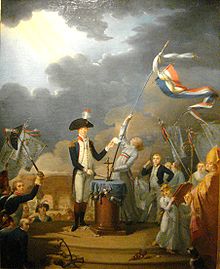 The oath of Lafayette at the Fête de la Fédération, 14 July 1790. Talleyrand, then Bishop of Autun can be seen on the right. The standing child is the son of La Fayette, the young Georges Washington de La Fayette. French School, 18th century. Musée Carnavalet.
The oath of Lafayette at the Fête de la Fédération, 14 July 1790. Talleyrand, then Bishop of Autun can be seen on the right. The standing child is the son of La Fayette, the young Georges Washington de La Fayette. French School, 18th century. Musée Carnavalet.
On 15 July, Lafayette was acclaimed commander-in-chief of the National Guard of France, an armed force established to maintain order under the control of the Assembly.[81][82] Lafayette proposed the name and the symbol of the group: a blue, white and red cockade.[77][80] On 5 October 1789, a Parisian crowd, composed mostly of rough women working in the markets selling fish, marched to Versailles in response to the scarcity of bread. Members of the National Guard followed the march, and when Lafayette said that this march is non-sense, the National Guard's men openly defied his power and according to some sources, they said "We are going with you, or over you", then Lafayette reluctantly led the National Guard army to Versaille. At Versailles, the king accepted the Assembly's votes but refused requests to return to Paris. That evening, Lafayette replaced most of the royal bodyguards with National Guardsmen. At dawn, the crowd broke into the palace. Before it succeeded in entering the queen's bedroom, Marie Antoinette fled to the king's apartments. Lafayette took the royal family onto the palace balcony and attempted to restore order.[83][84] The crowd insisted that the king and his family move to Paris where they were installed in the Tuileries Palace.[85][86] At the balcony, King Louis simply appeared, and everyone started chanting "Vive le Roi!". Then when Maria Antoinette appeared with her children, she was told to send the children back, afterwards, when she came out alone, people shouted to shoot her, but when she stood her ground facing almost certain death, no one opened fire. After several seconds and the lowering of rifles, people started to chant "Vive la Reine!" ("Long live the Queen", now the crowd is including the Queen)
As leader of the National Guard, Lafayette attempted to maintain order. On 12 May 1790, he instituted, along with Jean Sylvain Bailly (mayor of Paris), a political club called the "Society of 1789" . The club's intention was to provide balance to the influence of the Jacobins.[87] On 14 July 1790, Lafayette took the civic oath on the Champs de Mars, vowing to "be ever faithful to the nation, to the law, and to the king; to support with our utmost power the constitution decreed by the National Assembly, and accepted by the king."[88]
He continued to work for order in the coming months. On 20 February 1791, the Day of Daggers, Lafayette traveled to Vincennes in response to an attempt to liberate a local prison. Meanwhile, armed nobles converged around the Tuileries, afraid the unprotected king would be attacked. Lafayette returned to Paris to disarm the nobles.[89] On 18 April, the National Guard disobeyed Lafayette and stopped the King from leaving for Saint-Cloud over Easter.[80][90][91]
Decline: Flight to Varennes, Champs de Mars, and the Parisian Mayoral election
On 20 June 1791, an unsuccessful plot, called the Flight to Varennes, nearly allowed the king to escape from France. As leader of the National Guard, Lafayette had been responsible for the royal family's custody. He was thus blamed by Danton for the mishap and called a "traitor" to the people by Maximilien Robespierre.[92] These accusations portrayed Lafayette as a royalist, and damaged his reputation in the eyes of the public.[93] The episode garnered support throughout the country for the Republican movement, and "polarized" the king's supporters.[94]
Through the latter half of 1791, Lafayette's stature continued to decline. On 17 July, the Cordeliers organized an event, at the Champs de Mars, to gather signatures on a petition which called for a referendum on Louis XVI.[95] The assembled crowd, estimated to be up to 10,000, hanged two men believed to be spies after they were found under a platform.[96]
In response, the Assembly asked Bailly, the mayor of Paris, to "halt the disorder";[97] martial law was declared; and National Guard troops, under Lafayette, marched to the scene.[97] Lafayette, at the head of the column, carried a red flag to signify martial law. The National Guard under Lafayette tried to disperse the crowd without the use of violence. The National Guards' first attempts were successful and the crowd dispersed. However, later that same day it assembled again,[95] in part due to speeches given by Georges Danton and Camille Desmoulins. At some point stones were thrown at the troops. Lafayette is thought to have ordered his troops to fire warning shots into the air. When the crowd did not back down, Lafayette ordered his men to fire into the crowd. Senior Officers in the National Guard questioned after the event stated they found it hard to control the actions of the volunteer soldiers. Many injuries were reported though not all were fatal; this is generally thought to have been due to the disorganization and inexpert actions taken by the National Guard in the quelling of the disorder. Exact numbers of deaths are unknown; estimates generally range from a dozen to fifty.[96][97] Because of these confusions, the sequence of events at the Champ de Mars remains unclear and contested.
In combination with the Flight to Varennes, this event, known as the 'Champs de Mars Massacre' (Fusillade du Champs de Mars), furthered the public's mistrust of Lafayette and Bailly; in the aftermath, Lafayette resigned from the National Guard and Bailly left his post as mayor.[94] In November, Lafayette ran against Jérôme Pétion de Villeneuve in the mayoral election to succeed Bailly, but lost by a large margin. Criticism plagued Lafayette's mayoral campaign: his role in the flight to Varennes and in the Champs de Mars massacre were denounced both by politicians on the left and right.[98]
Conflict and imprisonment
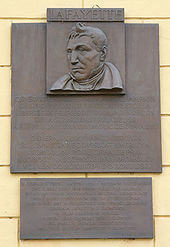 Lafayette memorial plaque at Olomouc
Lafayette memorial plaque at Olomouc
Lafayette returned to his home province of Auvergne following the loss of the mayoral election.[98] France declared war on Austria on 20 April 1792, and preparations to invade the Southern Netherlands (known at that time as the Austrian Netherlands, and in the future as Belgium), were begun; Lafayette received command of one of the three armies, at Metz.[99] The war proceeded poorly: Lafayette, along with Jean-Baptiste Donatien de Vimeur, comte de Rochambeau and Nicolas Luckner, asked the Assembly to begin peace proceedings, as the generals feared the army would collapse if forced to attack.[100]
In June 1792, Lafayette criticized the growing influence of the radical clubs through a letter to the Assembly from his field post,[101] and ended his letter by calling for radical parties to be "closed down by force".[100] Earlier, in May, he had secretly proposed to a Brussels diplomat that the war be stopped until he achieved peace in Paris, perhaps by force. Lafayette's prior actions, despite the proposal's secrecy, caused suspicions that he planned a coup d'état. Marie-Antoinette advised authorities of Lafayette's plan, since she did not favor the constitution.[100] Lafayette left his command and returned to Paris on 28 June, where he asked the Assembly for the radical parties to be outlawed, the National Guard to defend the monarchy, and for the Constitution to be upheld.[102][103] His return augmented suspicions that he planned a coup d’état. Again, Lafayette and the Feuillants proposed to save the constitutional monarchy and royal family by uniting his army with General Luckner's. Marie-Antoinette refused: Lafayette had lost the support of the monarchy and the radical parties of the Revolution.[104][105]
On 8 August, a vote of impeachment was held against him for abandoning his post, in which more than two thirds voted against.[105] Two days later, a mob attacked the Tuileries and massacred the Swiss Guard. The King and his family sought refuge in the Legislative Assembly who, under armed threat, suspended Louis XVI and convoked the National Convention. Commissioners dispatched by the Paris Commune arrived at Sedan, where Lafayette now led the French Northern Army, to inform him of the events and to secure allegiance to the new government. Lafayette refused their offer of an executive role in the new government, and ordered them arrested, as he found them to be "agents of a faction which had unlawfully seized power."[106] New commissioners came to Sedan and informed Lafayette that he had been relieved of his command. On 19 August, the Assembly declared Lafayette a traitor, giving him the almost certain prospect of being guillotined if he fell into the hands of the new, radical authorities in France.[106]
Lafayette had already decided to flee with his similarly endangered staff officers to the Republic of the United Netherlands (Dutch Republic). Lafayette hoped to gather his family in Britain, then retire to the United States,[107][108] but did not make it. Troops of the counter-revolutionary coalition of Austria and Prussia had been massing in the Southern Netherlands, to invade France with the intention of restoring the old French monarchy. Flemish Austrian troops under Major General (later Field Marshal) Johann von Moitelle arrested Lafayette's party the evening of 17 August at Rochefort, Belgium, at that time a village in the officially neutral Prince-Bishopric of Liège. Among those arrested with Lafayette were Jean Baptiste Joseph, chevalier de Laumoy, Louis Saint Ange Morel, chevalier de la Colombe, Alexandre-Théodore-Victor, comte de Lameth, Charles César de Fay de La Tour-Maubourg, Marie Victor de Fay, marquis de Latour-Maubourg, Juste-Charles de Fay de La Tour-Maubourg, Jean-Xavier Bureau de Pusy.[109][110][111][112] From 25 August to 3 September 1792, he was held at Nivelles; then transferred to Luxemburg where an Austrian-Prussian-French royalist military tribunal declared him, César de La Tour-Maubourg, Jean Bureaux de Pusy, and Alexandre de Lameth, all previously deputies in the French National Convention, to be "prisoners of state" for their leading roles in the Revolution. The tribunal sentenced them to an incarceration that was to last until, as was anticipated by coalition rulers, a restored French king could render final judgment on the prisoners for their alleged political crimes. On 12 September 1792, a Prussian military escort received the men from their Austrian guards. The party travelled down the Moselle river to Coblentz, then down the Rhine river to the Prussian fortress-city of Wesel, where the Frenchmen remained in the central citadel from 19 September to 22 December 1792. When victorious French revolutionary troops began to threaten the Rhineland, King Frederick William II of Prussia transferred the prisoners east to the citadel at Magdeburg, where they remained an entire year, from 4 January 1793 to 4 January 1794.
When Frederick William decided that he could gain very little by continuing to battle the astonishingly effective revolutionary forces of the young Republic of France, and that there were much easier pickings for his army in the Kingdom of Poland, he stopped armed hostilities with the Republic and turned the state prisoners back over to his erstwhile coalition partner, the Habsburg Austrian monarch Francis II, Holy Roman Emperor. Prussian escorts assembled Lafayette, Latour-Maubourg, and Bureaux de Pusy at Nysa (Neisse) in Silesia, near the northern border of the emperor's territories of the Czech lands (today's Czech Republic).[113] On 17 May 1794, a further escort drove them by carriage to the border, where an Austrian military unit was waiting to receive them. The next day, around midnight, the Austrians delivered their captives into a barracks-prison, formerly a college of the Jesuits, in the fortress-city of Olomouc (Olmütz), Moravia. Lafayette occupied two rooms with thick walls and large windows covered by two sets of grills, overlooking the city's southern fortifications.[114][115]
An international network of supporters centered in Philadelphia, London, Hamburg-Altona, and Paris lobbied for Lafayette's release and the amelioration of his prison conditions. It also established communications with him and helped him plot break-outs. The most spectacular escape attempt was sponsored by Alexander Hamilton's sister-in-law Angelica Schuyler Church and her husband John Barker Church, a British Member of Parliament who had once served as commissary general of the American Continental Army. They hired as agent a multilingual young physician from the British Electorate of Hanover, Justus Erich Bollmann, who established contact with Lafayette in prison and acquired an assistant, a South Carolinian medical student named Francis Kinloch Huger. Remarkably, Lafayette had stayed his first night in America, in 1777, at the home of Huger's father Major Benjamin Huger. With the help of Bollmann and Francis Huger, Lafayette managed to escape an escorted carriage drive in the countryside outside Olomouc, a drive granted by the emperor for health purposes. While the rescuers were subduing an unexpectedly ferocious Austrian sergeant, they shouted for Lafayette to ride off north toward the border, on the mount they had provided. However, Lafayette soon disappeared from his rescuers' sight and lost his way in the countryside. That evening, 8 November 1794, a tanner suspicious of Lafayette's ungrammatical, French-accented German, reported him to the mayor of village Rýžoviště (Braunseifen) near Šternberk, who laid an ambush, took Lafayette into custody, and returned him to Olomouc.[116]
Lafayette's wife, Adrienne, had also been enduring a long captivity. It began on 17 September 1792, when she was placed under house arrest. Adrienne appealed to the Americans for assistance.[117] For political reasons, the young nation could not officially assist the family, although they retroactively paid Lafayette $24,424 for his military service, and Washington personally sent money. In May 1794, during the Reign of Terror, she was transferred to the La Force Prison in Paris; she went from prison to prison, and, but for American diplomatic efforts on her behalf, would have shared the death of her sister, mother, grandmother, and other relatives at the guillotine. Finally, after the fall of Robespierre and his radical Jacobin party, she gained her release on 22 January 1795.[118]
Adrienne organized the family's finances and appealed to the U.S. for American passports. James Monroe secured passports for Adrienne from Connecticut, which had granted the entire Lafayette family citizenship. Their son Georges, who was hiding to avoid execution, was sent to the U.S.[119] She, however, travelled with her two teenage daughters Anastasie and Virginie to Dunkirk and embarked for the Danish port of Altona (later Altona, Hamburg) and the adjacent free imperial city of Hamburg. There she hired a bilingual servant, bought a carriage, and travelled southeast through the German states to Vienna for an audience with Francis II. Taken by surprise, Francis granted permission for her and the daughters to live with Lafayette in captivity. Lafayette, who had endured harsh solitary confinement since his escape attempt a year previously, was flabbergasted when soldiers opened his prison door to usher in his wife and daughters on 15 October 1795. For the next two years, the family spent the days confined together in Lafayette's original two rooms, while the daughters spent the nights in a third, adjacent room.[120][121]
Through the press, diplomacy, and personal appeals, Lafayette's sympathizers on both sides of the Atlantic made their influence felt, most importantly on the French legislative chambers, Directory, foreign ministry, and army. A young, victorious general, Napoleon Bonaparte negotiated the release of the state prisoners at Olomouc, as a prelude to the Treaty of Campo Formio. Thus Lafayette's captivity of over five years had come to an end. The Lafayette family and their comrades in captivity left Olomouc under Austrian escort early on the morning of 19 September 1797, crossed the Bohemian-Saxonian border north of Prague, and were officially turned over to the American consul in Hamburg on 4 October.[122][123]
The French Directors and Napoleon Bonaparte saw Lafayette as a political rival, however, and did not want him to return to France. He remained in exile in the Danish province of Holstein and the Batavian Republic for two more years, until Napoleon Bonaparte's coup d'état of 18 Brumaire, 9 November 1799. Lafayette used the change of regime to slip into France with a passport in the name of "Motier". He managed to convince an angry Napoleon that he planned to live in rural obscurity. Not wanting to serve in Napoleon's army, Lafayette resigned his commission.[124] The Lafayettes retired to La Grange, which Adrienne had inherited from her mother. Admirers soon came to La Grange, including Charles James Fox.
Later life
Lafayette was unwilling to cooperate with Napoleon's government. In 1804, Napoleon was crowned Emperor after a plebiscite in which Lafayette did not participate. He remained relatively quiet, although he spoke publicly on Bastille Day events.[125] After the Louisiana Purchase, Jefferson asked if he would be interested in the governorship. Lafayette declined, citing personal problems and the desire to work for liberty in France.[126] During a trip to Auvergne, Adrienne became ill, largely due to her time in prison. In 1807, she became delirious but recovered enough on Christmas Eve to gather the family around her bed and to say to Lafayette: "Je suis toute à vous" ("I am all yours").[127] She died the next day.[128]
The Hundred Days
He was elected to the Chamber of Representatives under the Charter of 1815, during the Hundred Days, which called for Napoleon to abdicate after Waterloo. Lucien Bonaparte came before the assembly to denounce abdication. Lafayette replied:
By what right do you dare accuse the nation of...want of perseverance in the emperor's interest? The nation has followed him on the fields of Italy, across the sands of Egypt and the plains of Germany, across the frozen deserts of Russia.... The nation has followed him in fifty battles, in his defeats and in his victories, and in doing so we have to mourn the blood of three million Frenchmen.[129]
Charbonnerie
Louis XVIII and the ultra-royalists became increasingly repressive. In 1823, Lafayette was involved in the Saint-Amand Bazard conspiracy, in the premature Charbonnerie insurrection at Belfort. France intervened against the liberal government in Spain, increasing patriotism, and discrediting dissent. In 1825 Charles X was crowned, and the ultra-loyalists consolidated power.
Grand tour of America
Main article: Visit of the Marquis de Lafayette to the United States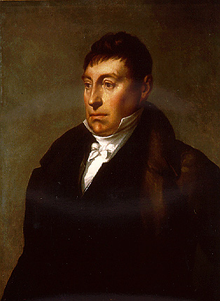 Portrait of General Lafayette (by Matthew Harris Jouett) in 1825
Portrait of General Lafayette (by Matthew Harris Jouett) in 1825
 A lighthouse clock made by Simon Willard to commemorate the visit of the Marquis to the U. S. White House library.
A lighthouse clock made by Simon Willard to commemorate the visit of the Marquis to the U. S. White House library.
President James Monroe invited Lafayette to visit the United States from August 1824 to September 1825, in part to celebrate the nation's 50th anniversary.[21] During his trip, he visited all 24 American states, traveling more than 6,000 miles (9,656 km).[130][131] Lafayette arrived from France at Staten Island in New York, on 15 August 1824, to an artillery salute.[132] The towns and cities he visited, including Fayetteville, North Carolina, the first city named in his honour, gave him enthusiastic welcomes.[130] During this tour he recognized and embraced James Armistead Lafayette, a free negro who took his last name to honor him, while in Yorktown, the story of the event was reported by the Richmond Enquirer. On 17 October 1824, Lafayette visited Mount Vernon and George Washington's tomb. On 4 November 1824, he visited Jefferson at Monticello, and on the 8th he attended a public banquet at the University of Virginia.[133] Subsequently, he accepted an invitation for honorary membership to the University's Jefferson Literary and Debating Society. In late August 1825, he returned to Mount Vernon.[134] A military unit decided to adopt the title National Guard, in honour of Lafayette's celebrated Garde Nationale de Paris. This battalion, later the 7th Regiment, was prominent in the line of march when Lafayette passed through New York before returning to France on the frigate USS Brandywine.[130] Late in the trip, he again received honorary citizenship of Maryland. Lafayette was feted at the first commencement ceremony of George Washington University in 1824. He was voted, by the U.S. Congress, the sum of $200,000 and a township of land located in Tallahassee, Florida to be known as the Lafayette Land Grant.[135][136]
Accession of Louis-Philippe
As the restored monarchy of Charles X became more conservative, Lafayette re-emerged as a prominent public figure. He had been a member of the Chamber of Deputies from Seine-et-Marne since 1815 and had pursued the abdication of Napoleon.[137][138] Throughout his legislative career, he continued to endorse causes such as freedom of the press, suffrage for all taxpayers, and the worldwide abolition of slavery.[139] He was not as directly visible in public affairs as in previous years; however, he became more vocal in the events leading up to the July Revolution of 1830.[140]
When the monarch proposed that theft from churches be made a capital crime, agitation against the Crown increased.[140] On 27 July 1830, Parisians began erecting barricades throughout the city, and riots erupted. Lafayette established a committee as interim government. On 29 July 1830, the commission asked Lafayette to become dictator, but he demurred to offer the crown to Louis-Philippe. Lafayette was reinstated as commander of the National Guard by the new monarch, who revoked the post after Lafayette's inconsistent command during the trial of D'Artois's ministers and to marginalize the Republican opposition which Lafayette led de facto.[141]
Death
Lafayette spoke for the last time in the Chamber of Deputies on 3 January 1834. The winter was wet and cold, and the next month he collapsed at a funeral from pneumonia. Although he recovered, the following May was wet and, after a thunderstorm, he became sick and bedridden.[142] On 20 May 1834, Lafayette died. He was buried next to his wife at the Picpus Cemetery[143] under soil from Bunker Hill, which his son Georges sprinkled upon him.[141][144] King Louis-Philippe ordered a military funeral in order to keep the public from attending. Crowds formed to protest their exclusion from Lafayette's funeral.[130]
François-René de Chateaubriand reported on Lafayette's death, and expressed regret for participation in the early mistreatment of his reputation in France:
In this year of 1834, Monsieur de Lafayette died. I may already have done him an injustice in speaking of him; I may have represented him as a kind of fool, with twin faces and twin reputations; a hero on the other side of the Atlantic, a clown on this. It has taken more than forty years to recognize qualities in Monsieur de Lafayette which one insisted on denying him. At the rostrum he expressed himself fluently and with the air of a man of breeding. No stain attaches to his life; he was affable, obliging and generous.[145]
Honors
Further information: Lafayette (disambiguation)See also: Fayette County (disambiguation), Lafayette County (disambiguation), Fayette (disambiguation), Fayetteville (disambiguation), Fayette Township (disambiguation), Lafayette Township (disambiguation), and Lafayette Park (disambiguation)American President Andrew Jackson ordered that Lafayette be accorded the same funeral honours as John Adams and George Washington. Therefore, 24-gun salutes were fired from military posts and ships, each shot representing a U.S. state. Flags flew at half mast for thirty-five days, and "military officers wore crepe for six months".[146][147] The Congress hung black in chambers and asked the entire country to dress in black for the next thirty days.[148]
Lafayette was widely commemorated in the U.S. In 1824, the U.S. government named Lafayette Park in his honor; it lies immediately north of the White House in Washington, D.C. In 1826, Lafayette College was chartered in Easton, Pennsylvania. Lafayette was honored with a monument in New York City in 1917.[149] Portraits display Washington and Lafayette in the chamber of the U.S. House of Representatives.[150] Numerous towns, cities, and counties across the United States were named in his honor.
On 4 July 1917, shortly after the U.S. entered World War I, Colonel Charles E. Stanton visited the grave of Lafayette and uttered the famous phrase "Lafayette, we are here." After the war, a U.S. flag was permanently placed at the grave site. Every year, on Independence Day, the flag is replaced in a joint French-American ceremony.[151] The flag remained even during the German occupation of Paris during World War II.
On visiting Corsica in 1943, General George S. Patton commented on how the Free French forces had liberated the birthplace of Napoleon, and promised that the Americans would liberate the birthplace of Lafayette. Already an American citizen,[60][61][62] Lafayette was granted honorary United States citizenship by Congress in 2002. The honor was also extended to all his descendants.[152] The Order of Lafayette was established in 1958 by U.S. Representative Hamilton Fish III, a World War I veteran, to promote Franco-American friendship and to honor Americans who fought in France. The frigate Hermione, in which Lafayette returned to America, has been reconstructed in the port of Rochefort, Charente-Maritime, France.[153]
 The aircraft carrier USS Langley was renamed La Fayette by France
The aircraft carrier USS Langley was renamed La Fayette by France
Several warships were named after Lafayette. The French Navy acquired USS Langley in 1951 and renamed it La Fayette. A modern stealth frigate is also named after Lafayette, and is also the name of a ship class, La Fayette.
The French ocean liner SS Normandie was to be the troopship USS Lafayette after being acquired by the US Government, but was destroyed by a fire before conversion to the new role was completed. The name was later given to a ballistic missile submarine.
The city of Fayetteville, North Carolina, is named after General Lafayette. While many cities are named after Lafayette, Fayetteville was the first and holds the distinction of being the only one he actually visited. He arrived in Fayetteville by horse-drawn carriage in 1825.
James McHenry, whom Lafayette considered a good friend, built a country seat on 95 acres and named it Fayetteville in his honor. He purchased it in 1792 from a tract called Ridgely's Delight about a mile west of Baltimore. [154]
Lafayette, the county seat of Tippecanoe County, Indiana, was named after him.
Lafayette Park, one of the first public parks created in 1833 by the City of Saint Louis, Missouri, was named in honor of the Marquis de Lafayette in 1854.
Many streets around the United States are named for Lafayette, such as Lafayette Street in New Haven, Connecticut, Lafayette Street in Williston Park and Lafayette Street (Manhattan). New York City actually has five Lafayette Streets, one in each borough, as well as a Lafayette Avenue in Brooklyn. US 1 in New Hampshire, from the Massachusetts border in Seabrook to Portsmouth, is named Lafayette Road.
Lafayette in sculpture
- pediment on the Tippecanoe County Courthouse, Lafayette, Indiana, 1882
- LaFayette Fountain by Lorado Taft in Lafayette, Indiana, 1887
- Statue of Lafayette and Washington by Bartholdi, Place des États-Unis (United States Plaza), Paris, France, 1895
- Equestrian statue by Paul Bartlett, Metz, France 1919, destroyed by German occupation forces and replaced by another statue by M . Goutin in 2004
-
pediment on the Tippecanoe County Courthouse, Lafayette, Indiana, 1882
-
LaFayette Fountain, Lafayette, Indiana
See also
- Lafayette College
- LaFayette Motors
- Place des États-Unis
Notes and references
- ^ a b Clary, pp. 7, 8
- ^ Historians differ on the spelling of Lafayette's name: Lafayette, La Fayette, and LaFayette. Contemporaries often used "La Fayette", similar to his ancestor, the novelist Madame de La Fayette; however, his immediate family wrote Lafayette. – Gottschalk, pp. 153–154
- ^ a b Officer, p. 171
- ^ a b c d Gaines, p. 33
- ^ a b Clary, pp. 11–13
- ^ a b Gottschlk, pp. 3–5
- ^ Adams, p. 12
- ^ Clary, p. 28
- ^ Holbrook, p. 15
- ^ Charlemagne Tower (1894). The Marquis de La Fayette in the American Revolution. J.B. Lippincott Company. p. 88. http://books.google.com/?id=vDuF70s1Eu4C&pg=PA22&dq=de+kalb.
- ^ "Nelson, ''Francis Rawdon-Hastings, Marquess of Hastings'', p.55". Alibris.com. http://www.alibris.com/search/books/qwork/8802888/used/Francis%20Rawdon-Hastings,%20Marquess%20of%20Hastings:%20Soldier,%20Peer%20of%20the%20Realm,%20Governor-General%20of%20India. Retrieved 9 August 2009.
- ^ Unger, p.24
- ^ a b c d e f g h i Holbrook, pp. 15–16
- ^ Gottschalk, p.66-82
- ^ Clary, p. 75
- ^ a b c Holbrook, p. 17
- ^ Gaines, p. 56
- ^ Clary, p. 83
- ^ Charlemagne Tower (1894). The Marquis de La Fayette in the American Revolution. p. 34. http://books.google.com/?id=vDuF70s1Eu4C&pg=PA22&dq=de+kalb.
- ^ Holbrook, pp. 13, 71
- ^ a b Glathaar, p. 3
- ^ Cloquet, p. 37
- ^ Grizzard, p. 174
- ^ a b Martin, p. 195
- ^ Holbrook, p. 20
- ^ "The Moland House". The Moland House. http://moland.org/index.php. Retrieved 29 September 2008.
- ^ Gaines, p. 70
- ^ Clary, p. 100
- ^ Holbrook, p. 23
- ^ Gaines, p. 75
- ^ Grizzard, p. 175
- ^ Cloquet, p. 203
- ^ "Valley Forge National Historic Park". National Park Service. http://www.nps.gov/vafo/historyculture/lafayette.htm. Retrieved 20 October 2008.
- ^ Palmer, pp. 276, 277
- ^ Greene, p. 140, 141
- ^ Gaines, p. 112
- ^ Holbrook, pp. 28, 29
- ^ Fiske, pp. 89–92
- ^ Clary, p. 243
- ^ Cloquet, p. 155
- ^ Clary, p. 254
- ^ Clary, p. 257
- ^ Holbrook, p. 44
- ^ a b c d Gaines, pp. 153–155
- ^ Gaines, James (September 2007). "Washington & Lafayette". Smithsonian Magazine Online (Smithsonian). http://www.smithsonianmag.com/history-archaeology/washington_main.html?c=y&page=3. Retrieved 21 October 2008.
- ^ a b Holbrook, pp. 53–54
- ^ Holbrook, p. 43
- ^ Clary, pp. 330–338
- ^ Holbrook, p. 56
- ^ Clary, p. 350
- ^ Holbrook, p. 63
- ^ Tuckerman, p. 154
- ^ Holbrook, p. 65
- ^ a b Kaminsky, pp. 34, 35
- ^ Beth Sica (9 August 2002). "''La Belle Gabrielle'', Lafayette and Slavery, Lafayette College". Ww2.lafayette.edu. http://ww2.lafayette.edu/~library/special/specialexhibits/slaveryexhibit/onlineexhibit/gabrielle.htm. Retrieved 9 August 2009.
- ^ Unger, p.216
- ^ Loveland, p. 16
- ^ Hirschfeld, p. 126
- ^ Gaines, pp. 201, 202
- ^ a b Speare, Morris Edmund "Lafayette, Citizen of America", New York Times, 7 Sept. 1919. The article contains a facsimile and transcript of the Maryland act: " An Act to naturalize Major General the Marquiss de la Fayette and his Heirs Male Forever. ... Be it enacted by the General Assembly of Maryland—that the Marquiss de la Fayette and his Heirs male forever shall be and they and each of them are hereby deemed adjudged and taken to be natural born Citizens of this State and shall henceforth be instilled to all the Immunities, Rights and Privileges of natural born Citizens thereof, they and every one of them conforming to the Constitution and Laws of this State in the Enjoyment and Exercise of such Immunities, Rights and Privileges."
- ^ a b Folliard, Edward T. "JFK Slipped on Historical Data In Churchill Tribute" Sarasota Journal, 25 May 1973.
- ^ a b Cornell, Douglas B. "Churchill Acceptance 'Honors Us Far More'" Sumter Daily Item, 10 April 1963.
- ^ Holbrook, pp. 67–68
- ^ Gaines, pp. 198–99, 204, 206
- ^ Gottschalk, Lady in Waiting, p. 155
- ^ Gottshalk (1939). A Lady in Waiting. Baltimore: Johns Hopkins Press. p. 95.
- ^ Gottschalk, Between, p.16-17
- ^ Wright, pp. 23–24
- ^ Gottshalk (1939). A Lady in Waiting. Baltimore: Johns Hopkins Press. p. 96.
- ^ Maurois, Adrienne: The Life of the Marquise de La Fayette, p.113
- ^ Tuckerman, p. 198
- ^ Neely, p. 47
- ^ Tuckerman, p. 210
- ^ Doyle, p. 74, 90
- ^ Tuckerman, p. 213
- ^ de La Fuye, p. 83.
- ^ a b Gerson, pp. 81–83
- ^ Crowdy, p. 7
- ^ Note: Lafayette later sent Washington the key.
- ^ a b c Doyle, pp. 112–13
- ^ Tuckerman, p. 230
- ^ Crowdy, p. 42
- ^ Hampson, p. 89
- ^ Neely, p. 86
- ^ Doyle, p. 122
- ^ Clary, p. 392
- ^ Thiers, p. vi
- ^ Cloquet, p. 305
- ^ Doyle, p. 148
- ^ Jones, p. 445
- ^ Frey, p. 92
- ^ Gaines, pp. 345, 346
- ^ Holbrook, p. 100
- ^ a b Neely, p. 126, 179
- ^ a b Andress, p. 51
- ^ a b Andress, The French Revolution and the people, p. 151
- ^ a b c Neely, p. 128
- ^ a b Andress, p. 61
- ^ Broadwell, p. 28
- ^ a b c Andress, 72-5
- ^ Broadwell, p. 36
- ^ Doyle, p. 186
- ^ Morris, Vol. I, p.458
- ^ Andress, pp. 78, 80, 87
- ^ a b Broadwell, p. 37
- ^ a b Tuckerman, p. 84-5
- ^ Clary, p. 409
- ^ Spalding, pp. 5–6
- ^ Holbrook, p. 114
- ^ Doyle, p. 190
- ^ Lafayette Collection, Library of Congress, Reel 1, Folder 2A
- ^ Spalding, pp. 2–3, 6–7
- ^ Spalding, pp. 10–30
- ^ Spalding, pp. 70–76
- ^ Lafayette Collection, Library of Congress, Reel 1, Folder 5 & 5A
- ^ Spalding, pp. 66–69, 84–124
- ^ Clary, pp. 410–16.
- ^ Details appear in Maurois
- ^ Clary, p. 413
- ^ Clary, p. 418
- ^ Spalding, pp. 140–56
- ^ Holbrook, p. 129
- ^ Spalding, pp. 173–227
- ^ Holbrook, pp. 141–42
- ^ Holbrook, p. 146
- ^ Kennedy, p. 210
- ^ Crawford, p. 318
- ^ Clary, p. 438
- ^ Gaines, page 427
- ^ a b c d Clary, pp. 443, 444
- ^ Loveland, p. 3
- ^ Cloquet, p. 302
- ^ "''Marquis de Lafayette'', Th. Jefferson Encyclopedia, Thomas Jefferson Foundation, Inc". Wiki.monticello.org. 15 October 2008. http://wiki.monticello.org/mediawiki/index.php/Marquis_de_Lafayette. Retrieved 9 August 2009.
- ^ Mount Vernon Estate & Gardens. "Washington & Lafayette". Washington & Lafayette. http://www.mountvernon.org/visit/plan/index.cfm/pid/349/. Retrieved 12 August 2008.
- ^ "Historic Markers Program of America". Historicmarkers.com. http://www.historicmarkers.com/component/content/article/2773-leon/59282. Retrieved 9 August 2009.
- ^ Holbrook, p. 177
- ^ Gaines, p. 427
- ^ Holbrook, p. 162
- ^ Clary, pp. 442–445
- ^ a b Holbrook, p. 188
- ^ a b Clary, pp. 443–445, 447, 448
- ^ Payan, p.93
- ^ Marquis de Lafayette at Find a Grave
- ^ Kathleen McKenna (10 June 2007). "On Bunker Hill, a boost in La Fayette profile". Boston Globe. http://www.boston.com/news/local/articles/2007/06/10/on_bunker_hill_a_boost_in_lafayette_profile/. Retrieved 5 May 2008.
- ^ Chateaubriand, Bk XLII: Chap3: Sec1
- ^ Gaines, p. 448
- ^ Clary, p. 448
- ^ Clary, p. 449
- ^ "Marquis de Lafayette". New York City Department of Parks & Recreation. 7 March 2002. http://www.nycgovparks.org/sub_your_park/historical_signs/hs_historical_sign.php?id=13307. Retrieved 11 August 2008.
- ^ Ike Skelton (22 May 2007). "House Record: Honoring The Marquis De Lafayette On The Occasion Of The 250th Anniversary Of His Birth: Section 29". GovTrack.us. http://www.govtrack.us/congress/record.xpd?id=110-h20070522-29. Retrieved 11 August 2008.
- ^ "Lafayette and the American Flag: The Fourth of July Ceremony". http://www.francerevisited.com/main/node/173. Retrieved 31 July 2009.
- ^ Public Law 107-209
- ^ (French) Robert Kalbach. "L'Hermione". L'Hermione. L’association Hermione-La Fayette. http://hermione.free.fr/english/rebuild.html. Retrieved 11 August 2008.
- ^ Bernard C. Steiner and James McHenry, The life and correspondence of James McHenry (Cleveland: Burrows Brothers Co., 1907).
Works cited
- Adams, William Howard (1997). The Paris years of Thomas Jefferson. Yale University Press. ISBN 9780300082616. http://books.google.com/?id=wUYTAOwDMP8C&dq=Lafayette+memoirs+my+heart+was+enlisted.
- d'Agrain, Charles (1797). Captivité de la Fayette. Héroïde, avec figures, et des Notes historiques, non encore connues du Public, sur les Illustres Prisonniers d'Olmutz, en Moravie. http://www.ilab.org/db/book2433_13163.html.
- Andress, David (2006). French Revolution and the people. Continuum International Publishing Group. ISBN 9781852855406. http://books.google.com/?id=0QTkXl5egfoC&dq=andress+massacre+champ+de+mars.
- Andress, David (2006). The Terror: The Merciless War for Freedom in Revolutionary France. Macmillan. ISBN 9780374273415. http://books.google.com/?id=zDfxQDcQzJ0C&pg=PA61&dq=andress+the+terror+page+lafayette+bailly+petion.
- An Officer in the Late Army (1825). A Complete History of the Marquis de Lafayette: Major-General in the American Army in the War of the Revolution. Columbus, Ohio: J. & H. Miller. http://books.google.com/?id=6FuZ-K3PMtcC&pg=PA170&dq=marquis+de+lafayette+visited+10+states+1784.
- de Chateaubriand, François (2007). Mémoires d’outre-tombe. A. S. Kline. http://tkline.pgcc.net/PITBR/Chateaubriand/ChateaubriandMemoirsBookXLII.htm#BkXLIICh3Sec1.
- Broadwell, William. Outlines of the Life of General Lafayette; With an Account of the French Revolution of 1830, Until the Choice of Louis Philip as King. ISBN 9781151283535. http://www.paperbackswap.com/Outlines-Life-General-William-Broadwell-Co/book/1151283533/.
- Clary, David (2007). Adopted Son: Washington, Lafayette, and the Friendship that Saved the Revolution. New York, New York: Bantam Books. ISBN 9780553804355. http://books.google.com/?id=cgGgAAAACAAJ&dq=adopted+son.
- Cloquet, Jules; Isaiah Townsend (1835). Recollections of the Private Life of General Lafayette. Baldwin and Cradock. http://books.google.com/?id=aGsFAAAAQAAJ&pg=PA202&dq=%22battle+of+gloucester%22#PPA203,M1.
- Crawford, Mary MacDermot (1907). Madame de Lafayette and Her Family. J. Pot & co. http://books.google.com/?id=VkxBAAAAIAAJ&dq=%22je+suis+toute+a+vous%22+lafayette.
- Crowdy, Terry; Patrice Courcelle (2004). French Revolutionary Infantry 1789–1802. Osprey Publishing. ISBN 9781841766607. http://books.google.com/?id=UAmGRjaOASgC&dq=de+broglie+storming+of+the+bastille.
- Doyle, William (1990). Oxford history of the French Revolution (3rd ed.). Oxford: Oxford University Press. ISBN 0192852213. http://books.google.com/?id=N7chHQAACAAJ&dq=Oxford+history+of+the+French+Revolution.
- Fiske, John (1902). Essays, Historical, and Literary: Scenes and characters in American History. New York: Macmillan. http://books.google.com/?id=wUsaAAAAYAAJ&pg=PA89&dq=Lafayette+Battle+of+Monmouth+Courthouse.
- Gaines, James R. (2007). For Liberty and Glory: Washington, La Fayette, and Their Revolutions. W.W. Norton & Co.. ISBN 9780393061383. http://books.google.com/?id=gOD2fRZcqJQC&dq=for+liberty+and+glory.
- Gerson, Noel B. (1976). Statue in Search of a Pedestal: a Biography of the Marquis de La Fayette. New York: Dodd, Mead & Company. ISBN 9780396073413. http://books.google.com/?id=KY-dAAAACAAJ&dq=Statue+in+Search+of+a+Pedestal:+a+Biography+of+the+Marquis+de+La+Fayette.
- Glatthaar, Joseph T.; James Kirby Martin (2007). Forgotten Allies, The Oneida Indians and the American Revolution. Macmillan Publishers. ISBN 9780809046003. http://books.google.com/?id=J777rlgcm9sC&dq=marquis+de+lafayette.
- Gottschalk, Louis (2007). Lafayette comes to America. Read Books. ISBN 1406727938. http://books.google.com/?id=xYUQ-Rpt284C&dq=marquis+de+lafayette+childhood.
- Gottschalk, Louis (1939). A Lady in Waiting. Baltimore: Johns Hopkins Press.
- Gottschalk, Louis (1950). Lafayette: Between the American and the French Revolution (1783–1789). Chicago: University of Chicago Press.
- Greene, Francis Vinton (1911). The Revolutionary War and the Military History of the United States. New York: Charles Scribner's Sons. http://books.google.com/?id=awcpAAAAYAAJ&pg=PA140&dq=Lafayette+Barren+Hill#PPR3,M1.
- Grizzard, Frank (2002). George Washington: Biographical Companion. ABC-CLIO. ISBN 9781576070826. http://books.google.com/?id=RioTGCygpT8C&dq=31+july+1777+lafayette.
- Hirschfeld, Fritz (1997). George Washington and Slavery – A Documentary Portrayal. U.S.A.: University of Missouri Press. ISBN 9780-8262-1135-4. http://books.google.com/?id=4YX3czE0SGYC&dq=Fritz+Hirschfeld+washington+slavery.
- Holbrook, Sabra (1977). Lafayette, Man in the Middle. Atheneum. ISBN 0689305850. http://books.google.com/?id=UXdKAAAACAAJ&dq=lafayette+man+in+the+middle.
- Kaminsky, John (2005). A Necessary Evil?: Slavery and the Debate of the Constitution. Rowman & Littlefield. ISBN 0945612338. http://books.google.com/?id=t3SDQgfxsCIC&dq=Lafayette+emancipation+of+slaves+Washington.
- Lacretelle, Charles (1806). Précis historique de la Révolution française. Treuttel et Würtz. http://books.google.com/?id=81gPAAAAQAAJ&pg=PA74&lpg=PA74&dq=%22bureau+de+puzi%22.
- La Fayette Villaume Ducoudray Holstein, Henri (1824). Memoirs of Gilbert Motier La Fayette. Charles Wiley. http://books.google.com/?id=HcgEAAAAYAAJ&pg=RA1-PA303&dq=. Retrieved 11 August 2008.
- de La Fuye, Maurice; Émile Albert Babeau (1956). The Apostle of Liberty: A Life of Lafayette. New York: Thomas Yoseloff, Inc. ISBN 9780801055553. http://books.google.com/?id=0bQ7AAAAMAAJ&q=The+Apostle+of+Liberty:+A+Life+of+Lafayette&dq=The+Apostle+of+Liberty:+A+Life+of+Lafayette.
- Levasseur, August (2006). Lafayette in America. Alan Hoffman. Lafayette Press. ISBN 978-0-97872-240-1. http://www.lafayetteinamerica.com/.
- Leepson, Marc (2011). Lafayette: Lessons in Leadership From the Idealist General. Palgrave Macmillan. ISBN 978-0-230-10504-1. http://www.marcleepson.com/.
- Loveland, Anne (1971). Emblem of Liberty: The Image of Lafayette in the American Mind. LSU Press. ISBN 0807124621. http://books.google.com/?id=r5uqsO1KQ5YC&dq=lafayette%27s+death.
- Martin, David (2003). The Philadelphia Campaign. Da Capo Press. ISBN 0306812584. http://books.google.com/?id=qUIePpgvfl4C&dq=silas+deane+marquis+de+lafayette+commission.
- Maurois, André (1961). Adrienne, the Life of the Marquise de La Fayette. McGraw-Hill. http://books.google.com/books?id=uCReAAAAIAAJ&q=adrienne,+the+life+of+the+marquise&dq=adrienne,+the+life+of+the+marquise.
- Du Motier Lafayette, Gilbert; George Washington (1837). Memoirs, Correspondence and Manuscripts of General Lafayette. William Alexander Duer. Saunders and Otley. http://books.google.com/?id=bHIFAAAAQAAJ.
- Morris, Gouverneur (1888). The Diary and Letters of Gouverneur Morris. Volume I. Anne Cary Morris. C. Scribner's Sons. http://www.archive.org/stream/diarylettersmorris01morrrich/diarylettersmorris01morrrich_djvu.txt.
- Morris, Gouverneur (1888). The Diary and Letters of Gouverneur Morris. Volume II. Anne Cary Morris. C. Scribner's Sons. http://books.google.com/?id=a8H4WNGMXnQC&dq=gouvenour+morris+diary&printsec=frontcover.
- Neely, Sylvia (2008). A Concise History of the French Revolution. Rowman & Littlefiel. ISBN 0742534111. http://books.google.com/?id=fccjTyOQiYwC&dq=lafayette+and+declaration+the+rights+of+man.
- Palmer, Dave Richard (2006). George Washington and Benedict Arnold: A Tale of Two Patriots. Regnery Publishing. ISBN 9781596980204. http://books.google.com/?id=o_tZvGEc3uUC&dq=lafayette+and+the+conway+cabal.
- Payan, Gregory (2002). Marquis de Lafayette:French Hero of the American Revolution. The Rosen Publishing Group. ISBN 0823957330. http://books.google.com/?id=cV454kuJiHMC&dq=payan+la+fayette.
- Spalding, Paul S. (2010). Lafayette: Prisoner of State. University of South Carolina Press. ISBN 9781570039119. http://www.amazon.com/Lafayette-Prisoner-Paul-S-Spalding/dp/1570039119/ref=sr_1_1?s=books&ie=UTF8&qid=1291075561&sr=1-1.
- Thiers, M. A.; Frederic Shoberl (1846). The History of the French Revolution. 1 (3 ed.). London: Richard Bentley. http://books.google.com/?id=JJUaAAAAYAAJ&pg=PR6&dq=lafayette+society+of+1789.
- Tower, Charlemagne (1894). The Marquis de La Fayette in the American Revolution. J.B. Lippincott Company. http://books.google.com/?id=vDuF70s1Eu4C&pg=PA22&dq=de+kalb.
- Tuckerman, Bayard (1889). Life of General Lafayette: With a Critical Estimate of His Character and Public Acts. Dodd, Mead. http://books.google.com/?id=C7kYAAAAYAAJ&dq=lafayette+chief+of+staff.
- Unger, Harlow Giles (2002). Lafayette. Hoboken, New Jersey: John Wiley & Sons. ISBN 0471394327. http://www.amazon.com/Lafayette-Harlow-Giles-Unger/dp/0471394327.
- Wright, Constance (1959). Madame de Lafayette. New York: Holt, Rhinehart, and Winston. LOC 59-6675. http://www.archive.org/stream/madamedelafayett006987mbp/madamedelafayett006987mbp_djvu.txt.
External links
French Armed Forces Components French Air Force French Army French Navy Gendarmerie Ranks Ranks in the French Army Ranks in the French Navy History of the French Military Military History of France La Grande Armée - Works by Gilbert du Motier, (formerly)Marquis de Lafayette at Project Gutenberg
- French Founding Father at the New-York Historical Society
- The Cornell University Library Lafayette Collection
- The Marquis de Lafayette collection, Cleveland State University
- Lafayette College, The Marquis de Lafayette Collections
- Marquis de Lafayette Collection, Library of Congress
- Martha Joanna Lamb, Lafayette letters from prison, The Magazine of American History with Notes and Queries, pp. 353–376
- Works by or about Gilbert du Motier, marquis de Lafayette in libraries (WorldCat catalog)
French nobility Preceded by
Michel Louis Christophe Roch Gilbert Paulette du MotierMarquis de Lafayette Succeeded by
title abolishedCategories:- 1757 births
- 1834 deaths
- People from Haute-Loire
- American Roman Catholics
- Continental Army generals
- French generals
- French military personnel of the French Revolutionary Wars
- French nobility
- French people of the American Revolution
- French Roman Catholics
- Burials at Picpus Cemetery
- French Marquesses
- Military leaders of the French Revolutionary Wars
- Occitan people
- People of the French Revolution
- University of Paris alumni
- Members of the Society of the Cincinnati
Wikimedia Foundation. 2010.

